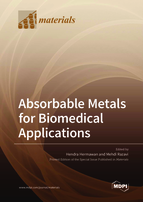Absorbable Metals for Biomedical Applications
A special issue of Materials (ISSN 1996-1944). This special issue belongs to the section "Biomaterials".
Deadline for manuscript submissions: closed (31 May 2021) | Viewed by 47450
Special Issue Editors
Interests: absorbable metals; metallic biomaterials; coating and surface modification; metallurgy and electrochemisty of corrosion
Special Issues, Collections and Topics in MDPI journals
Interests: biodegradable magnesium implants; biomaterials; tissue engineering; regenerative medicine; nanomedicine
Special Issue Information
Dear Colleagues,
Absorbable metals, as the ASTM and ISO standards named them, and known also as biodegradable metals, are metals and alloys that are intended for use in biomedical applications, mainly as materials for temporary implants, such as endovascular stents, bone plates and screws, and porous scaffolds. They are expected to be completely degraded and absorbed in the body after providing a needed function, thus eliminating the harmful potential effects of permanent implants. The introduction of these metals has shifted the established paradigm of metal implants from preventing corrosion to taking advantage of it. Interest in these metals has been growing in the past decade, as indicated by the rapid increase in scientific publications, the progressive development of standards, and the launching of commercial products. The families of absorbable metals can be grouped into iron, magnesium, zinc, and their alloys. The magnesium group is considered as the most studied family, both in basic and translational research. The iron group has become the subject of significant efforts to overcome its major challenge of low in vivo corrosion rates. While the zinc group is the newly added member of absorbable metals. ASTM has officially published the F3160 standard guide for metallurgical characterization of absorbable metals and the ASTM F3268 standard guide for in vitro degradation testing of absorbable metals, while the ISO is coordinating an “umbrella” document with standards that are related to biological evaluation. This Special Issue aims to present the latest works in the research and development of absorbable metals, to solicit the most important findings, to highlight the remaining challenges, and to provide the perspectives on the future direction.
Assoc. Prof. Dr. Hendra Hermawan
Assist. Prof. Dr. Mehdi Razavi
Guest Editors
Manuscript Submission Information
Manuscripts should be submitted online at www.mdpi.com by registering and logging in to this website. Once you are registered, click here to go to the submission form. Manuscripts can be submitted until the deadline. All submissions that pass pre-check are peer-reviewed. Accepted papers will be published continuously in the journal (as soon as accepted) and will be listed together on the special issue website. Research articles, review articles as well as short communications are invited. For planned papers, a title and short abstract (about 100 words) can be sent to the Editorial Office for announcement on this website.
Submitted manuscripts should not have been published previously, nor be under consideration for publication elsewhere (except conference proceedings papers). All manuscripts are thoroughly refereed through a single-blind peer-review process. A guide for authors and other relevant information for submission of manuscripts is available on the Instructions for Authors page. Materials is an international peer-reviewed open access semimonthly journal published by MDPI.
Please visit the Instructions for Authors page before submitting a manuscript. The Article Processing Charge (APC) for publication in this open access journal is 2600 CHF (Swiss Francs). Submitted papers should be well formatted and use good English. Authors may use MDPI's English editing service prior to publication or during author revisions.
Keywords
- Absorbable
- Alloy
- Biodegradable
- Biomaterials
- Composites
- Corrosion
- Implant
- Iron
- Magnesium
- Medical
- Metal
- Standard
- Zinc








